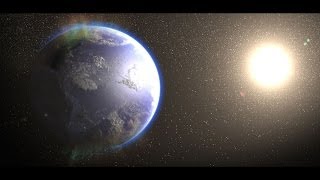(单词翻译:单击)
All the material objects around you are composed of submicroscopic units we call molecules.
围绕在你周围的所有物质都是由极小的单位体构成的,我们叫它们分子。
And molecules in turn are composed of individual atoms.
同时分子又是由单独的原子构成。
Molecules frequently break apart and then form new molecules.
分子常常分裂,然后构成新的分子。
On the other hand, virtually all the atoms you come in to contact with through the course of your life,
换句话说,我们一生中接触的所有原子,
the ones in the ground beneath you, the air you breath, the food you eat,
你脚下的土地,你所呼吸着的空气,你吃着的食物,
those that make up every living thing, including you,
构成所有生命体,包括你在内的原子,
have existed for billions of years and were created in places very unlike our planet.
已经存在了数十亿年,并由与地球大为不同的空间组成。
How those atoms came about is what I want to share with you.
今天我就要与你们分享这些原子是如何产生的。
It all started 14 billion years ago with an event we call The Big Bang,
这些是都从140亿年前我们所称之为的宇宙大爆炸时开始,
which resulted in a universe consisting of gas alone.
大爆炸形成了只有气体的宇宙。
There were no stars and no planets. The gas was made up only of atoms belonging to the simplest elements.
没有任何恒星和行星。而气体只由原子组成,这些原子属于最简单的元素。
It was about 75 percent hydrogen and almost all the rest was helium.
其中大约有75%的氢,剩下的则都是氦。
No elements like carbon, oxygen or nitrogen existed. No iron, silver or gold.
像碳、氧、氮等元素都是不存在的,也没有铁、银或金。
In some places, the density of this gas was slightly higher than in others.
在某些地方,这些气体的密度会比别的地方稍高。
Due to gravity, those places attracted even more gas,
由于重力因素,密度高地方就会吸引更多的气体,
which further strengthened the pull of gravity, which then drew more gas in, and so on.
并且使重力增加,于是更多的气体被吸引,并以这种形式一直循环下去。
Eventually, large dense gas balls formed, shrinking under their own gravity and consequently heating up on the inside.
最终形成了体积大且密度高的气体球,它们依靠自身的重力在内部产生热量。
At some point, the core of such a ball gets hot enough that nuclear fusion occurs.
从某种角度来看,是这种球体中心的原子核结合产生的炙热。
Hydrogen atoms smash together to form helium, accompanied by a great release of energy,
氢聚集形成氦,释放出巨大的能量,
strong enough to counteract the shrinking force of the gravity.
足够抵消使球体缩小的重力。
When the energy pushing out from the fusion reactions matches the gravity pulling all the gas inwards, an equilibrium occurs.
从这种反应开始释放出的能量与进入内部的气体重力相同的话,即形成了球形体。
From this a star is born.
因此一个恒星也就诞生了。
Over its lifetime, the fusion reactions in the core of a massive star will produce not only helium,
这颗恒星存在期间,从巨大的恒星中心引起的融合反应,不仅产生了氦气,
but also carbon, oxygen, nitrogen and all the other elements in the periodic table up to iron.
还有碳、氧气及氮气,以及元素周期表中诸如铁等所有元素。
But eventually, the core's fuel runs out, leaving it to collapse completely.
但是随着中心燃料的逐渐减少,最后将消耗殆尽。
That causes an unbelievably powerful explosion we call a supernova.
那时,将引起难以置信的大爆炸,那就是我们所说的超新星。
Now there are two things to note about how supernovas create elements.
现在我们要了解关于超新星是如何制造的元素的两件事。

First, this explosion releases so much energy that fusion goes wild
首先,这种爆炸会释放巨大的能量,
forming elements with atoms even heavier than iron like silver, gold and uranium.
继而形成游离的比铁更重的元素,如银、金和铀原子等。
Second, all the elements that had been accumulating in the core of the star,
其次,聚集在恒星中心的所有元素,
like carbon, oxygen, nitrogen, iron, as well as all of those formed in the supernova explosion,
如碳、氧、氮、铁,它们不仅是由那些超新星爆炸形成的,
are ejected in to interstellar space where they mix with the gas that's already there. History then repeats itself.
而且包括宇宙空间喷涌而出的这些元素与已存在的气体混合,以这种形式循环往复,
Gas clouds, now containing many elements besides the original hydrogen and helium,
气体云现在含多种元素,不单只有氢和氦,
have higher density areas that attract more matter, and so on.
并有更高密度的空间去吸引更多的物质。
As before, new stars result. Our sun was born this way about 5 billion years ago.
因此,一颗新的恒星诞生了。我们的太阳就是在50亿年前以这种方式诞生的。
That means that the gas it arose from had itself been enriched with many elements
也就是说,产生太阳的气体云,吸收过多种元素,
from supernova explosions since the universe began.
自宇宙开始超新星爆发时。
So that's how the sun wound up with all the elements.
所以太阳中拥有所有的元素。
It's still mostly hydrogen at 71 percent, with most of the rest being helium at 27 percent.
不过其中占最大比例的是71%的氢,以及27%的氦。
But bear in mind that while the first stars were made up of hydrogen and helium alone,
然而要知道的是,即使最初的恒星仅由氢和氦构成,
the remaining elements in the periodic table make up two percent of the sun. And what about Earth?
元素周期表中的剩余元素还是组成了太阳的其余2%。我们的地球又如何呢?
Planets form as an incidental process to star formation out of the same gas cloud as the star itself.
行星是依照恒星形成的过程,由同样的气体云聚合产生的。
Small planets like ours don't have enough gravity to hold on to much hydrogen or helium gas since both of those are very light.
像地球这样的小行星由于重力不够,无法留住过多的氢和氦,毕竟氢和氦太轻了。
So, even though carbon, nitrogen, oxygen and so on made up only two percent of the gas cloud from which Earth was formed,
因此,即使碳、氮、氧等只组成了形成地球的气体云的2%,
these heavier elements form the bulk of our planet and everything on it.
但这些元素却构成了地球的地面和地上的所有东西。
Think about this: with the exception of hydrogen and some helium,
想一想,除了氢和氦之外,
the ground you walk on, the air you breath, you, everything is made of atoms that were created inside stars.
你脚下的土地,你呼吸的空气,以至于你本身,当中的原子均来自恒星。
When scientists first worked this out over the first half of the 20th Century,
因此当二十世纪前期科学家们刚得出这个结论时,
the famous astronomer Harlow Shapley commented, 'We are brothers of the boulders, cousins of the clouds.'
著名的天文学哈洛·沙普利曾说:“我们都是岩石的兄弟,云朵的表亲。”


